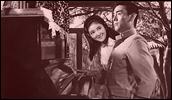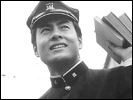Elegy to Violence
- Year
- 1966
- Original title
- Kenka Erejii
- Japanese title
- けんかえれじい
- Alternative title
- Fighting Elegy
- The Born Fighter
- Director
- Cast
- Running time
- 86 minutes
- Published
- 22 October 2001



by Jasper Sharp
Nowadays Seijun Suzuki seems to be primarily remembered as the eccentric force behind a succession of inventively staged yet generically plotted B-movie gangster flicks during the 1960s. In fact some of the director's more interesting work during his Nikkatsu years lay outside the action genre. When given more satisfying scripts to play with, as with the Goro Tanada penned Gate of Flesh, Suzuki proved that as a director his talents stretch far beyond the mere formal experimentation that most obviously manifested itself in such thematically less ambitious works as Branded to Kill.
Elegy to Violence, an adaptation of a Takashi Suzuki novel by renowned scriptwriter Kaneto Shindo (though substantially rewritten by the director to fit in with his pragmatic working methods) is certainly one of Suzuki's more conventional looking films, not to mention one of his more cohesive. Yet that's not to say that any of the director's impish humour has been lost in this fictitious fable set amongst the schoolyard scuffles of Okayama Junior High.
Set in 1935, the films central axis Kiroku (played by Hideki Takahashi, Nikkatsu matinee idol of some 88 features including Suzuki's Tattooed Life / Irezumi Ichidai between his debut in Kogenji in 1961 until leaving the studios in 1971, and currently a popular TV gameshow host) is one of a horde of surly adolescents who partake in a bit of testosterone-charged rough 'n tumble after the school bell has sounded, fighting under the aegis of the OSMS (Okayama Second Middle School) gang. "A famous group of young men training their bodies", the OSMS take their brawlings with their local rivals to paramilitary levels of hyperbole, lining their school bags with razor blades and carving shurikens out of wood, indulging in lengthy training sessions punching beanbags full of rocks and hitting each other with sticks in the forest.
The OSMS live by a number of tenets, including "A man finds rebellion most satisfying", and "No talking to softies". Unfortunately for Kiroku, who's got the hots for Michiko, the daughter of the owner of the Catholic boarding house where he lives, there's also "No chasing after girls". Kiroku, however, is quite willing to have his sentiments educated at the piano by Michiko in the privacy of the house, but when he is caught strolling through the cherry blossoms hand in hand with his sweetheart by Pickles, the leader of the OSMS, it's obvious that he's going to have to try that little bit harder to regain his face in front of his contemporaries.
"My main impression is still that war is ludicrous", the director stated about his own war experiences in a 1969 interview for the Japanese publication Cinema 69, a viewpoint that informs the whole tone of the Elegy to Violence as much as it does with any of his films. You can almost imagine Suzuki smirking behind the camera as he playfully pokes fun at the adolescent machismo that equates military discipline with virility. He later goes on in the same interview to recount a story in which during the war he was holed up in a house in Taiwan. "There was a bombing raid and a man was hit while 'doing it'. It would have been better if only the bottom half had been blown off, but that's the only part that was left, his charred bottom half."
As the students of the all-male school environment channel their sexual tensions into acts of aggression, Kiroku's personal diary is peppered with immortal lines such as "Oh Michiko! I don't masturbate, I fight!" Every time he finds himself hot under the collar at the thought of his virginal love interest ("my blood throbs at those white hands!"), with an upward glance to the crucifix on the wall of his Catholic boarding house, it's back out for another bout of backstreet brawling.
However, Shindo's script is more than a broad-edged attack on violence itself, but an absurdist look at the forces that gave rise to fascism in 1930s Japan. When Kiroku's unruly antics get him kicked out of school and he is sent to study in rural Aizu, he is unimpressed by the "Aizu spirit" of his classmates. Kiroku's catcalls of "Aizu monkeys!" single him out for attention amongst the local school gangs, but he soon emerges top dog, attracting the shadowy figure of real-life dissident writer and "founder of modern Japanese fascism", Ikki Kita in the process.
Kita was a strong advocate of National Socialism and was executed in 1937 for allegedly influencing the young officers who took place in the failed coup known as the "ni ni roku" incident that took place in February 26, 1936 (see our review of Yukio Mishima's Patriotism), in which 1400 soldiers occupied a number of key buildings in the center of Tokyo, and killed the Finance Minister and the Inspector General of Military Education. The goal was to restore direct rule to the Showa Emperor, Hirohito, by removing any corrupting influences from the politicians and capitalists then cluttering up the political process. Suzuki's film ends during the coup, in which a state of martial law has been declared in Tokyo. With the now-unattainable Michiko packed off to a nunnery, Kiroku embarks on a lengthy snowbound train journey to Tokyo to join Kita in the revolution.
Elegy to Violence may well be one of Suzuki's meatiest films, both in terms of its political satire and the sheer vigour of the bone-crushing violence on display. The widescreen scope is most impressively used in the lavishly staged fights between the various gangs, armed with swords, rocks and sticks. But Suzuki doesn't revel in these scenes of violence. The spectacle of a chaotic mass of writhing schoolboys, rendered all the more ridiculous by the fact that the actors wearing the uniforms are at least 10 years too old for their parts, is, as Suzuki quite rightly suggests, quite ludicrous. Suzuki knows as well as we all do that boys will be boys. It's when the playful scuffling goes beyond the boundaries of the school playground that we really need to start worrying.